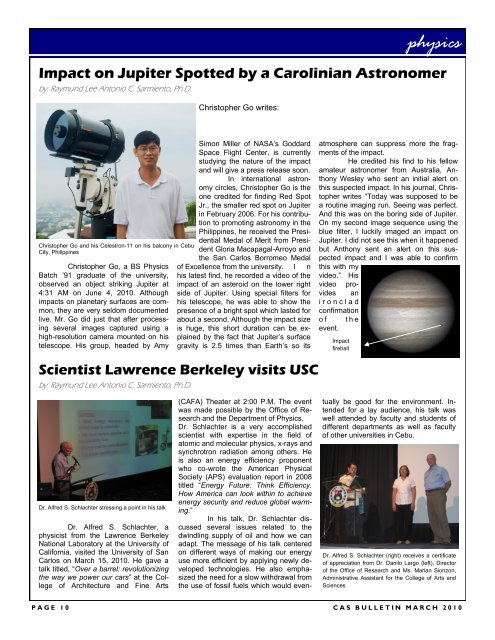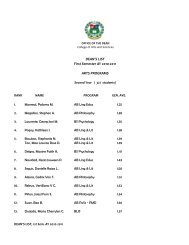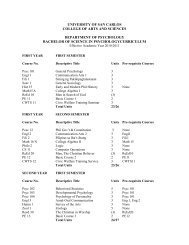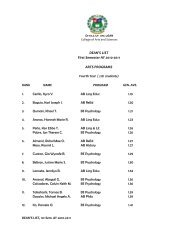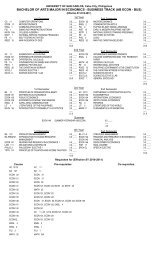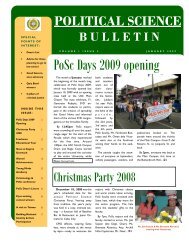CAS Hosts The Celebration Of - College of Arts and Sciences ...
CAS Hosts The Celebration Of - College of Arts and Sciences ...
CAS Hosts The Celebration Of - College of Arts and Sciences ...
You also want an ePaper? Increase the reach of your titles
YUMPU automatically turns print PDFs into web optimized ePapers that Google loves.
Simon Miller <strong>of</strong> NASA‘s Goddard<br />
Space Flight Center, is currently<br />
studying the nature <strong>of</strong> the impact<br />
<strong>and</strong> will give a press release soon.<br />
In international astronomy<br />
circles, Christopher Go is the<br />
one credited for finding Red Spot<br />
Jr., the smaller red spot on Jupiter<br />
in February 2006. For his contribution<br />
to promoting astronomy in the<br />
Philippines, he received the Presidential<br />
Medal <strong>of</strong> Merit from President<br />
Gloria Macapagal-Arroyo <strong>and</strong><br />
the San Carlos Borromeo Medal<br />
<strong>of</strong> Excellence from the university. I n<br />
his latest find, he recorded a video <strong>of</strong> the<br />
impact <strong>of</strong> an asteroid on the lower right<br />
side <strong>of</strong> Jupiter. Using special filters for<br />
his telescope, he was able to show the<br />
presence <strong>of</strong> a bright spot which lasted for<br />
about a second. Although the impact size<br />
is huge, this short duration can be explained<br />
by the fact that Jupiter‘s surface<br />
gravity is 2.5 times than Earth‘s so its<br />
physics<br />
Impact on Jupiter Spotted by a Carolinian Astronomer<br />
by: Raymund Lee Antonio C. Sarmiento, Ph.D.<br />
Christopher Go <strong>and</strong> his Celestron-11 on his balcony in Cebu<br />
City, Philippines<br />
Christopher Go, a BS Physics<br />
Batch ‘91 graduate <strong>of</strong> the university,<br />
observed an object striking Jupiter at<br />
4:31 AM on June 4, 2010. Although<br />
impacts on planetary surfaces are common,<br />
they are very seldom documented<br />
live. Mr. Go did just that after processing<br />
several images captured using a<br />
high-resolution camera mounted on his<br />
telescope. His group, headed by Amy<br />
Scientist Lawrence Berkeley visits USC<br />
by: Raymund Lee Antonio C. Sarmiento, Ph.D.<br />
Dr. Alfred S. Schlachter stressing a point in his talk<br />
Dr. Alfred S. Schlachter, a<br />
physicist from the Lawrence Berkeley<br />
National Laboratory at the University <strong>of</strong><br />
California, visited the University <strong>of</strong> San<br />
Carlos on March 15, 2010. He gave a<br />
talk titled, ―Over a barrel: revolutionizing<br />
the way we power our cars‖ at the <strong>College</strong><br />
<strong>of</strong> Architecture <strong>and</strong> Fine <strong>Arts</strong><br />
P A G E 1 0<br />
Christopher Go writes:<br />
(CAFA) <strong>The</strong>ater at 2:00 P.M. <strong>The</strong> event<br />
was made possible by the <strong>Of</strong>fice <strong>of</strong> Research<br />
<strong>and</strong> the Department <strong>of</strong> Physics.<br />
Dr. Schlachter is a very accomplished<br />
scientist with expertise in the field <strong>of</strong><br />
atomic <strong>and</strong> molecular physics, x-rays <strong>and</strong><br />
synchrotron radiation among others. He<br />
is also an energy efficiency proponent<br />
who co-wrote the American Physical<br />
Society (APS) evaluation report in 2008<br />
titled ―Energy Future: Think Efficiency.<br />
How America can look within to achieve<br />
energy security <strong>and</strong> reduce global warming.‖<br />
In his talk, Dr. Schlachter discussed<br />
several issues related to the<br />
dwindling supply <strong>of</strong> oil <strong>and</strong> how we can<br />
adapt. <strong>The</strong> message <strong>of</strong> his talk centered<br />
on different ways <strong>of</strong> making our energy<br />
use more efficient by applying newly developed<br />
technologies. He also emphasized<br />
the need for a slow withdrawal from<br />
the use <strong>of</strong> fossil fuels which would even-<br />
atmosphere can suppress more the fragments<br />
<strong>of</strong> the impact.<br />
He credited his find to his fellow<br />
amateur astronomer from Australia, Anthony<br />
Wesley who sent an initial alert on<br />
this suspected impact. In his journal, Christopher<br />
writes ―Today was supposed to be<br />
a routine imaging run. Seeing was perfect.<br />
And this was on the boring side <strong>of</strong> Jupiter.<br />
On my second image sequence using the<br />
blue filter, I luckily imaged an impact on<br />
Jupiter. I did not see this when it happened<br />
but Anthony sent an alert on this suspected<br />
impact <strong>and</strong> I was able to confirm<br />
this with my<br />
video.‖ His<br />
video provides<br />
an<br />
i r o n c l a d<br />
confirmation<br />
o f t h e<br />
event.<br />
Impact<br />
fireball<br />
tually be good for the environment. Intended<br />
for a lay audience, his talk was<br />
well attended by faculty <strong>and</strong> students <strong>of</strong><br />
different departments as well as faculty<br />
<strong>of</strong> other universities in Cebu.<br />
Dr. Alfred S. Schlachter (right) receives a certificate<br />
<strong>of</strong> appreciation from Dr. Danilo Largo (left), Director<br />
<strong>of</strong> the <strong>Of</strong>fice <strong>of</strong> Research <strong>and</strong> Ms. Marian Sionzon,<br />
Administrative Assistant for the <strong>College</strong> <strong>of</strong> <strong>Arts</strong> <strong>and</strong><br />
<strong>Sciences</strong><br />
C A S B U L L E T I N M A R C H 2 0 1 0


